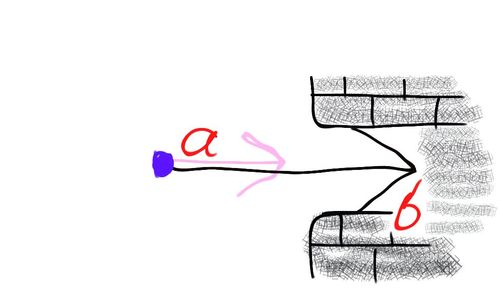lets play with hands of clock!
 Here, you see pink colored hour hand, black colored minute hand and the common axis as blue point. Length of hour hand is a, that of minute hand is b. Of course, a<b .
now, the minute hand is kept rigid, not allowed to rotate. The hour hand can rotate about the blue point ranging from angle 0 degree to 180 degree ( the angle hour hand is making with the minute hand here can range from 0 to 180 degrees).
Now, at an instant, hour hand is rotated by angle x. Then, join the tips of both the hands at that instant. Then, you will get a triangle. This way, you get many many triangles of different kinds for different angles.
The ratio of a to b is such that you will get an isosceles triangle once during rotation.
If you are allowed to change the hour hand with any other hour hand of a different length(but still smaller than b), then if you choose hour hand of length c, and value of c/b is such that on rotating from 0 to 180 degrees, you will get isosceles triangle 2 times- one triangle with 2 sides equal to b and other with 2 sides equal to c.
Which of the following statements are true:
Here, you see pink colored hour hand, black colored minute hand and the common axis as blue point. Length of hour hand is a, that of minute hand is b. Of course, a<b .
now, the minute hand is kept rigid, not allowed to rotate. The hour hand can rotate about the blue point ranging from angle 0 degree to 180 degree ( the angle hour hand is making with the minute hand here can range from 0 to 180 degrees).
Now, at an instant, hour hand is rotated by angle x. Then, join the tips of both the hands at that instant. Then, you will get a triangle. This way, you get many many triangles of different kinds for different angles.
The ratio of a to b is such that you will get an isosceles triangle once during rotation.
If you are allowed to change the hour hand with any other hour hand of a different length(but still smaller than b), then if you choose hour hand of length c, and value of c/b is such that on rotating from 0 to 180 degrees, you will get isosceles triangle 2 times- one triangle with 2 sides equal to b and other with 2 sides equal to c.
Which of the following statements are true:
A: c/b > 0.5 and a/b < 0.5
B: c/b is greater than or equal to 0.5 and a/b is smaller than or equal to 0.5
C: The above statements are false, the situation described in the question itself is not possible.
D: angle between hour and minute hand must be smaller than 60 degrees for isoceles triangle having 2 sides equal to c to be formed.
E: if hour hand is allowed to rotate by 360 degrees, then it is possible to get non congruent isosceles triangles 4 times.
This section requires Javascript.
You are seeing this because something didn't load right. We suggest you, (a) try
refreshing the page, (b) enabling javascript if it is disabled on your browser and,
finally, (c)
loading the
non-javascript version of this page
. We're sorry about the hassle.
Try this practically, and you will immediately realise the answers. however, try to solve it through mathematical statements.